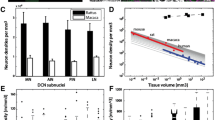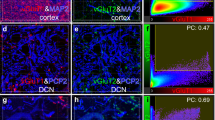Abstract
The classical comparative literature on mammalian brain evolution has mainly focused on brain mass measurements because larger brains are more likely to have more neurons to process information. The phylogenetic expansion in the mass of the cerebellum is as significant as that of the cerebral cortex. The synapse, however, has recently been recognized as the basic unit of neuronal information processing, including neuroplasticity. Here we hypothesize significant absolute and relative increases in the functionally important granule-cell-Purkinje-cell (gcPc) synapses as a salient feature of the evolving cerebellum. To probe evolutionary constraints, we define the gcPc circuitry with ten degrees of freedom, including number of granule cells, Purkinje cells, lengths of the granule cell axonal segments, linear densities of synapses along them, and physical dimensions of Purkinje as well as granule cell dendritic structures. We show that although only two of the ten parameters are not constrained and therefore can exhibit independent, comparative changes, there is a dramatic increase in the number of gcPc synapses from the rodent to the human cerebellum. By assigning a value of unity for the mouse, the ratio of the number of gcPc synapses from mouse, rat, cat, non-human primate, and human is 1:5.5:236:620:20,000, which greatly exceeds the ratio of increase in cerebellar mass (1:6:48:180:3000). Dramatic changes in the number of gcPc synapses can therefore occur despite evolutionary constraints and only modest changes in parameters of the neuronal circuitry. Increases in the number of gcPc synapses have important functional consequences as these synapses enhance the capacity of the cerebellum to code and process information, which directly impact memory and learning in both motor and non-motor tasks.
Similar content being viewed by others
References
Andersen, B.B., Korbo, L., Pakkenberg, B., 1992. A quantitative study of the human cerebellum with unbiased stereological techniques. J. Comp. Neurol. 326, 549–560.
Andersen, B.B., Gundersen, H.J., Pakkenberg, B., 2003. Aging of the human cerebellum: a stereological study. J. Comp. Neurol. 466, 356–365.
Attwell, P.J., Ivarsson, M., Millar, L., Yeo, C.H., 2002. Cerebellar mechanisms in eye-blink conditioning. Ann. N.Y. Acad. Sci. 978, 79–92.
Apps, R., Garwicz, M., 2005. Anatomical and physiological foundations of cerebellar information processing. Nat. Rev. Neurosci. 6, 297–311.
Bedi, K.S., Hall, R., Davies, C.A., Dobbing, J., 1980. A stereological analysis of the cerebellar granule and Purkinje cells of 30-day-old and adult rats undernourished during early postnatal life. J. Comp. Neurol. 193, 863–870.
Barmack, N.H., Yakhnitsa, V., 2011. Microlesions of the inferior olive reduce vestibular modulation of Purkinje cell complex and simple spikes in mouse cerebellum. J. Neurosci. 31, 9824–9835.
Brand, S., Dahl, A.L., Mugnaini, E., 1976. The length of parallel fibers in the cat cerebellar cortex. An experimental light and electron microscopic study. Exp. Brain Res. 26, 39–58.
Chklovskii, D.B., Mel, B.W., Svoboda, K., 2004. Cortical rewiring and information storage. Nature 431, 782–788.
Clark, D.A., Mitra, P.P., Wang, S.S., 2001. Scalable architecture in mammalian brains. Nature 411, 189–193.
DeFelipe, J., 2011. The evolution of the brain, the human nature of cortical circuits, and intellectual creativity. Front. Neuroanat. 5, 29, https://doi.org/10.3389/fnana.2011.00029 (published 16 May 2011).
De Zeeuw, C.I., Yeo, C.H., 2005. Time and tide in cerebellar formation. Curr. Opin. Neurobiol. 15, 667–674.
Fan, H., Favero, M., Vogel, M.W., 2001. Elimination of Bax expression in mice increases cerebellar Purkinje cell numbers but not the number of granule cells. J. Comp. Neurol. 436, 82–91.
Fox, C.A., Barnard, J.W., 1957. A quantitative study of the Purkinje cell dendritic branchlets and their relationship to afferent fibers. J. Anat.(London) 91, 299–313.
Gottlieb, G., 1984. Evolutionary trends and evolutionary origins: relevance to theory in comparative psychology. Psychol. Rev. 91, 448–456.
Gundappa-Sulur, G., De Schutter, E., Bower, J.M., 1999. Ascending granule cell axon: an important component of the cerebellar cortical circuitry. J. Comp. Neurol. 408, 580–596.
Hansel, C., Linden, D.F., D’Angelo, E., 2001. Beyond parallel fiber LTD: the diversity of synaptic and non-synaptic plasticity in the cerebellum. Nat. Neurosci. 4, 407–475.
Harris, K.M., Stevens, J.K., 1988. Dendritic spine of rat cerebellar Purkinje cells: serial electron microscopy with reference to their biophysical characteristics. J. Neurosci. 8, 4455–4469.
Harvey, R.J., Napper, R.M.A., 1988. Quantitative study of granule and Purkinje cells in the cerebellar cortex of the rat. J. Comp. Neurol. 274, 151–157.
Herculano-Houzel, S., 2009. The human brain in numbers: a linearly scaled-up primate brain. Front. Hum. Neurosci. 3, 31, https://doi.org/10.3389/neuro.09.031.2009.
Herculano-Houzel, S., 2010. Coordinated scaling of cortical and cerebellar numbers of neurons. Front. Neuroanat. 4, 1–8 (art 12).
Herculano-Houzel, S., 2011. Not all brains are made the same: new views on brain scaling in evolution. Brain Behav. Evol. 78, 22–36.
Herculano-Houzel, S., Mota, B., Lent, R., 2006. Cellular scaling rules for rodent brains. Proc. Natl. Acad. Sci. U.S.A. 103, 12138–12143.
Huang, C., Brown, N., Huang, R., 1999. Age-related changes in the cerebellum: parallel fibers. Brain Res. 840, 148–152.
Huang, C., Wang, L., Huang, R., 2006a. Cerebellar granule cell: ascending axon and parallel fiber. Eur. J. Neurosci. 23, 1731–1737.
Huang, C., 2008. Implications on cerebellar function from information coding. Cerebellum 7, 314–331.
Huang, C., Miyamoto, H., Huang, R., 2006b. The mouse cerebellum from one to thirty-four months: parallel fibers. Neurobiol. Aging 27, 1715–1718.
Ito, M., 1984. The Cerebellum and Neural Control. Raven Press, New York.
Ito, M., 2006. Cerebellar circuitry as a neuronal machine. Prog. Neurobiol. 78, 272–303.
Jorntell, H., Hansel, C., 2006. Synaptic memories upside down: bidirectional plasticity at cerebellar parallel fiber-Purkinje cell synapses. Neuron 52, 227–238.
Lange, W., 1975. Cell number and cell density in the cerebellar cortex of man and some other mammals. Cell Tissue Res. 157, 115–124.
Llinas, R. (Ed.), 1969. Neurobiology of Cerebellar Evolution and Development. Amer. Med. Assoc, Chicago.
Mayhew, T.M., 1991. Accurate prediction of Purkinje cell number from cerebellar weight can be achieved with the fractionator. J. Comp. Neurol. 308, 162–168.
Manto, M., Gruol, D., Schmahmann, J., Koibuchi, N., Rossi, F. (Eds.), 2012. Handbook of the Cerebellum and Cerebellar Disorders. Springer, New York.
Napper, R.M.A., Harvey, R.J., 1988a. Number of parallel fiber synapses on an individual Purkinje cell in the cerebellum of the rat. J. Comp. Neurol. 274, 168–177.
Napper, R.M.A., Harvey, R.J., 1988b. Quantitative study of the Purkinje cell dendritic spines inthe rat cerebellum. J. Comp. Neurol. 274, 158–167.
Palay, S.L., Palay, V., 1974. The Cerebellar Cortex: Cytology and Organization. Springer-Verlag, New York.
Palkovitz, M., Mezey, E., Hamori, J., Szentagothai, J., 1971a. Quantitative histological analysis of the cerebellar nucleus in the cat. I. Numerical data on cells and on synapses. Exp. Brain Res. 28, 189–209.
Palkovitz, M., Magyar, P., Szentagothai, J., 1971b. Quantitative histological analysis of the cerebellar cortex in the cat. II. Cell numbers and densities in the granular layer. Brain Res. 32, 15–30.
Palkovitz, M., Magyar, P., Szentagothai, J., 1971c. Quantitative histological analysis of the cerebellar cortex in the cat. III. Structural organization of the molecular layer. Brain Res. 34, 1–18.
Pichitpornchai, C., Rawson, J.A., Rees, S., 1994. Morphology of parallel fibers inthe cerebellar cortex of the rat: an experimental light and electron microscopic study with biocytin. J. Comp. Neurol. 342, 206–220.
Portmann, A., 1947. Etudes sur la cerebralisation chez les oiseauz: II Les indices intra-cerebraux. Atauda 15, 161–171.
Rockel, A.J., Hiorns, R.W., Powell, T.P., 1980. The basic uniformity in structure of the neocortex. Brain 103, 221–244.
Shepherd, G.M.G., Raastad, M., Andersen, P., 2002. General and variable features of varicosity spacing along unmyelinated axons in the hippocampus and cerebellum. Proc. Natl. Acad. Sci. U.S.A. 99, 6340–6345.
Smoljaninov, V.V., 1966. Structural-functional models of certain biological system. In: Gelfand, I.M., Gurfinkel, V.S., Fomin, S.V., Cetlin, M.L. (Eds.), Several Characteristics in the Organization of the Cerebellum. Izdatelstvo Nauka, Moscow, pp. 203–267 (in Russian).
Stephan, H., Frahm, H., Baron, G., 1981. New and revised data on volumes of brain structures in insectivores and primates. Folia Primatol. 35, 1–29.
Strick, P.L., Dum, R.P., Fiez, J.A., 2009. Cerebellum and nonmotor function. Ann. Rev. Neurosci. 32, 413–434.
Sturrock, R.R., 1989. Changes in neuron number in the cerebellar cortex of the aging mouse. J. Hirnforsch. 30, 499–503.
Sultan, F., 2002. Analysis of mammalian brain architecture. Nature 415, 133–134.
Thomson, R.F., Bao, S., Chen, L., Cipriano, B.D., Grethe, J.S., Kim, J.J., Thompson, J.K., Tracy, J.A., Weninger, M.S., Krupa, D.J., 1997. Associate Learning. In: Schmahmann, J.D. (Ed.), The Cerebellum and Cognition. Academic Press, New York.
Woodruff-Pak, D.S., 2006. Stereological estimation of Purkinje neuron number in C57BL/6 mice and its relation to associative learning. Neuroscience 141, 233–243.
Xu-Friedman, M.A., Harris, K.M., Regehr, W.G., 2001. Three-dimensional comparison of ultrastructural characteristics at depressing and facilitating synapses onto cerebellar Purkinje cells. J. Neurosci. 21, 6666–6680.
Yopak, K.E., Lisney, T.J., Darlington, R.B., Collin, S.P., Montgomery, J.C., Finlay, B.L., 2010. A conserved pattern of brain scaling from sharks to primates. Proc. Natl. Acad. Sci. U.S.A. 107, 12946–12951.
Author information
Authors and Affiliations
Corresponding author
Rights and permissions
About this article
Cite this article
Huang, C., Gammon, S.J., Dieterle, M. et al. Dramatic increases in number of cerebellar granule-cell-Purkinje-cell synapses across several mammals. Mamm Biol 79, 163–169 (2014). https://doi.org/10.1016/j.mambio.2013.12.003
Received:
Accepted:
Published:
Issue Date:
DOI: https://doi.org/10.1016/j.mambio.2013.12.003




